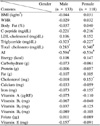1. Choi DS, Kim DK, Kim DM, Kim SY, Nam MS, Park YS, Shon HS, Ahan CW, Lee KW, Lee KU, Lee MK, Chung CH, Cha BH. 83 investigators. Efficacy evaluation of atorvastatin in Korean hyperlipidemic patients with Type 2 diabetes Mellitus. J Kor Diabetes Assoc. 2006. 30:292–302.

2. Yun KE, Park MJ, Park HS. Lack of management of cardiovascular risk factors in type 2 diabetic patients. Int J Clin Pract. 2007. 61:39–44.

3. Hobbs FD. Type-2 diabetes mellitus related cardiovascular risk:New options for interventions to reduce risk and treatment goals. Atherosclerosis Supplements. 2006. 7:29–32.
4. Cui R, Iso H, Toyoshima H, Date C, Yamamoto A, Kikuchi S, Kondo T, Watanabe Y, Koizumi A, Inaba Y, Tamakoshi A. JACC Study Group. Serum total cholesterol levels and risk of mortality from stroke and coronary heart disease in Japanese: the JACC study. Atherosclerosis. 2007. 194:415–420.

5. Lozano JV, Pallarés V, Cea-Calvo L, Llisterri JL, Fernández-Pérez C, Martí-Canales JC, Aznar J, Gil-Guillén V, Redón J. Investigators of the PREV-ICTUS Study. Serum lipid profiles and their relationship to cardiovascular disease in the elderly : the PREV-ICTUS study. Curr Med Res Opin. 2008. 24:659–670.
6. Cho HK. High density lipoprotein cholesterol comes of ages. Kor Circulation J. 2007. 37:187–190.
7. Simons LD. Interelations of lipids-lipoproteins with coronary artery disease mortality in 19 countries. AM J Cardiol. 1986. 27:20–106.
8. Castelli WP. Cholesterol and lipids in the risk of coronary heart disease:the Framingham Heart Study. Can J Cardiol. 1988. 4:5A–10A.
9. Assmann G, Schulte H. Relation of high-density lipoprotein cholesterol and triglycerides to incidence of atherosclerotic coronary disease (the PROCAM experience). AM J Cardiol. 1992. 70:733–737.
10. Multiple Risk Factor Intervention Trial Research Group. Multiple risk factor intervention trial. Risk factor changes and mortality results. JAMA. 1982. 248:1465–1477.
11. Gordon DJ, Knoke J, Probstifield JL, et al. High-density lipoprotein cholesterol and coronary heart disease in hypercholesterolemic men. The Lipid Research Clinics Coronary Prevention Trial. Circulation. 1986. 74:1217–1225.
12. Gordon DJ, Ekelund LG, Karon JM, et al. Predictive value of exercise test for mortality in North American men: the Lipid Research Clinics Mortality Follow-up study. Circulation. 1986. 74:252–261.
13. Forti N, Diament J. High-density lipoproteins: Metabolic, clinical, epidemiological and therapeutic intervention aspects. An update for clinicians. Arq Bras Cardiol. 2006. 87:671–679.
14. Expert Panel on Detection, Evaluation, and Treatment of High Blood Cholesterol in Adults. Executive Summary of the Third Report of the National Cholesterol Education Program (NCEP) Expert Panel on Detection, Evaluation, and Treatment of High Blood Cholesterol in Adults (Adult Treatment Panel III). JAMA. 2001. 285:2486–2497.
15. Friedewald WT, Levy RI, Fredrickson DS. Estimation of the concentration of low-density lipoprotein cholesterol in plasma, without use of the preparative ultracentrifuge. Clim Chem. 1972. 18:499–502.

16. Lauer RM, Lee J, Clarke WP. Factors affecting the relationship between childhood and adult cholesterol levels. The Muscatine study. Pediatrics. 1988. 82:309–318.
17. Oh SY, Kim EM, Shin MH, Lee SH, Kim JE, Lee HS, Jo JS, Kim WY. Development & validity of food frequency questionnaire for adults. 2007. In : The Korean society of health promotion, annual spring conference;
18. Kopp W. The atherogenic potential of dietary carbohydrate. Prev Med. 2006. 42:336–342.

19. Farvid MS, Jalali M, Siassi F, Hosseini M. Comparison of the effects of vitamins and/or mineral supplementation on glomerular and tubular dysfunction in type 2 diabetes. Diabetes care. 2005. 28:2458–2464.

20. Afkhami-Ardekani M, Shojaoddiny-Ardekani A. Effect of vitamin C on blood glucose, serum lipids & serum insulin in type 2 diabetes patients. Indian J Med Res. 2007. 126:471–474.
21. Kim WY, Kim JE, Choi YJ, Huh KB. Nutritional risk and metabolic syndrome in Korean Type2 diabetes mellitus. Asia Pac J Cli Nutr. 2008. 17:Suppl 1. 47–51.
22. Kim MH, Lee HS, Park HJ, Kim WY. Risk factors associated with metabolic syndrome in Korean elderly. Ann Nutr Metab. 2007. 51:533–540.

23. Yang EJ, Kim WY. The Influence of Dietary Factors on the Incidence of Non-Insulin-Dependent Diabetes Mellitus. Korean J Nutr. 1999. 32:407–418.
24. Ministry of health and welfare. The Third Korea National Health and Nutrition Examination Survey (KNHANES III). 2005.






 PDF
PDF ePub
ePub Citation
Citation Print
Print




 XML Download
XML Download